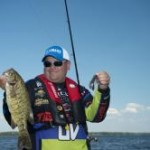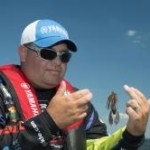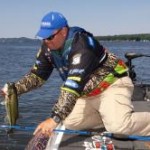from The Fishing Wire
Summer or winter, pro-angler Bill Lowen prefers a jig for deep water fishing.
Jigs have long been acknowledged as some of the most effective lures for winter bass fishing, but Yamaha Pro Bill Lowen considers them just as effective during the hot summer months, too. The only thing Lowen changes is how he presents the lure.
“I believe the presentation you use is actually more important than your jig choice,” explains Lowen, “and the reason is because in winter you’re going after lethargic, inactive bass, while in summer those same bass are far more active and willing to chase a jig. In winter, you’re usually hoping for a feeding-type response, but now in July and August, you can also generate totally different reflex-type strikes.”
Thus, while his primary jig presentation in winter is slowly dragging the lure along the bottom, Lowen’s summer presentation also includes a lot of hopping and even a technique known as “stroking.”
A football jig with a creature trailer does the job for most of his tournaments, says Lowen.“Stroking is a faster, stronger hopping presentation in which you literally rip the jig off the bottom with a hard upward sweep of your rod,” the Yamaha Pro explains. “The sudden change of direction and speed in the jig’s movement just triggers an instinctive strike. I may drag the jig on the bottom for a few feet, stroke it once and let it fall, then immediately rip it off the bottom again. I can do this three or four times during a single cast, too. It really depends on how the bass do react to it.
“During the summer, at least 75% of my jig bites come from hopping or stroking the lure like this.”
Lowen’s summer jig is the same as his winter one, a ½ or ¾-ounce football head style, and his preferred depth of 15 to 20 feet is also the same for both seasons. He also looks for breaklines where shallow water drops quickly to this depth.
“The major change for me in summer jig fishing is that I really want to have current consistently washing into that structure,” continues Lowen. “In the winter, I don’t want any current whatsoever, but it’s important this time of year. That water will be slightly cooler, it will have more oxygen, and it will be moving both forage and nutrients downstream with it.
Both largemouths and smallmouths like the “stroking” action that hops a jig off bottom in summer.“The most productive places are often the outsides of channel bends, and frequently, these will also contain some type of logs and brush that current has washed in. In other lakes, rocks or shell beds may be present. If you can find anything different like this on that structure, that’s nearly always the spot that attracts bass.”
To find current, Lowen frequently motors to the upper end of a lake where more river-like conditions usually exist, or far up large tributary streams. Normally, however, he does not fish the actual tailrace waters immediately below dams, primarily because he doesn’t have to.
“Sometimes, if a lot of water is being released from an upstream dam, all you need to do is get behind an island or main lake point that breaks the main water flow and re-directs it, and you’ll be able to catch bass,” the Yamaha Pro adds.
“It’s always better to cast upstream and let the current wash your jig down naturally. As you guide the lure with your rod tip, you can add the hopping and stroking action you need. Current usually positions bass behind rocks, logs, and other obstructions, so it’s not difficult to determine just exactly where to guide your jig.
“The fun part of all this during the summer is that every place where the current does wash into the structure you can find one smaller spot along it that will be better than the rest. It might be an area just one or two feet long within the entire bend of the channel, or perhaps just a single stump along that bend, but whatever it is, more bass will be on that small spot than anywhere else.”


